Film & Movies
Did you spot all of the in-jokes & Disney references in “Prep and Landing”?
WARNING !! There be spoilers ahead as Jim Hill reveals what co-directors / writers Kevin Deters & Stevie Wermers-Skelton hid under the tree in this new ABC holiday special

Okay. I know. JHM has already done a number of stories on “Disney Prep and Landing,” that new holiday special that Walt Disney Animation Studios produced exclusively for ABC (which – FYI – wound up being the highest rated Christmas special of the 2009 – 2010 season).
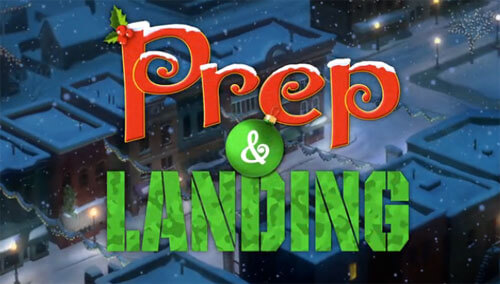
But if you’re making plans to watch tonight’s encore presentation (which airs on ABC from 8-8:30 p.m. ET/PT), I thought that you might enjoy knowing where to look in order to catch all of the inside jokes / stuff that “Disney Prep and Landing” co-directors / writers Kevin Deters and Stevie Wermers-Skelton hid in plain sight in this new holiday special.
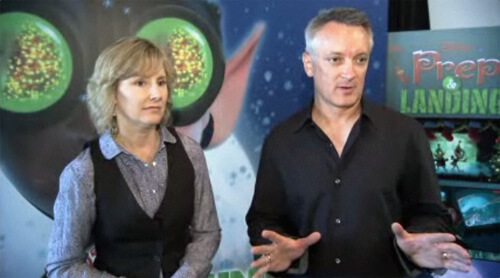
Take – for example – the German Shepherd that surprises Wayne and his old partner Peterson in this holiday special’s prologue. Does that dog look familiar? He should. Given that this CG canine is the title character of “Bolt” with a slightly different paint job.
“Walt Disney Feature Animation was just finishing ‘Bolt’ as we were gearing up production of ‘Prep and Landing.’ So we figured why reinvent the wheel?,” Deters explained. “That said, to make this reuse less obvious, we did change Bolt’s coloring from that of an American Shepherd to a German Shepherd dog. But – beyond that – it’s the same animation rig.”

Mind you, Bolt isn’t the only Disney dog to make a cameo appearance in “Prep and Landing.” Keep a close eye out for a Goofy-faced nightlight as Wayne & Lanny are putting Timmy back in bed.
“This is an extra special inside gag for Stevie and myself,” Kevin continued. “Given that the image of Goofy’s face that we use on that nightlight in Timmy Terwelp’s bedroom is actually from the poster for ‘How to Hook Up Your Home Theater.’ Which is the short that we co-directed for Disney. Stevie painted that poster herself, by the way.”
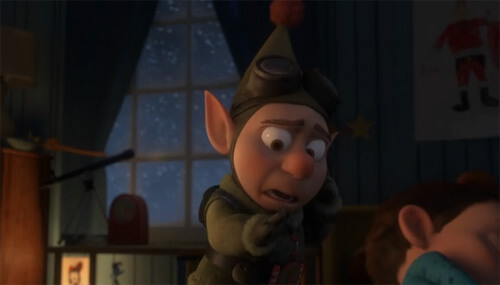
As for the next blink-and-you’ll-miss-it Disney reference, keep an eye out for a snow-covered station wagon in “Prep and Landing” ‘s action-packed finale. Did you catch the license plate number as Wayne & Lanny were skiing over that car? If not, it reads “12501 WED.” As in December 5, 1901. Which is Walt Disney’s birthday.

Then – of course – there’s that holiday special that Wayne watches while he’s goofing off at the Terwelps house. Which is “Mickey’s Christmas Carol,” the featurette that “Prep and Landing” producer John Lasseter worked on during his first stint at Walt Disney Animation Studios back in the late 1970s / early 1980s.
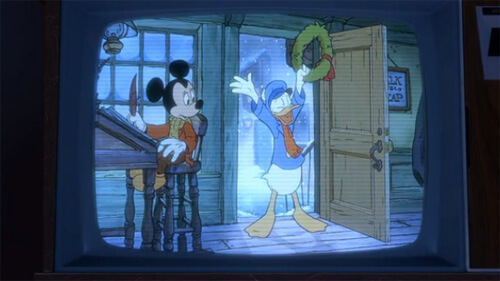
Copyright 2009 Disney Enterprises, Inc. All Rights Reserved
Beyond that … Deters & Wermers-Skelton take great pride in is the number of nods to Christmas classics and/or earlier holiday specials that they were able to slip into “Prep and Landing”.
“Timmy Terwelp is obviously our tribute to Tiny Tim from Charles Dickens’ ‘A Christmas Carol.’, “ Stevie said …

… “And if you look closely at the plant behind Magee’s desk, you’ll see that it’s actually the tree from ‘A Charlie Brown Christmas.’ “
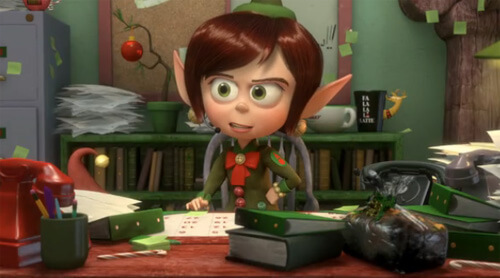
In fact, one of the funnier audio / visual gags in “Disney Prep and Landing” comes when Magee pours the dregs from her cup of Yuletide Joe into this flower pot. There’s this brief pause. Then – just like in “A Charlie Brown Christmas” – the needles fall off of that pitiful little Christmas tree with the exact same tinkle-tinkle-tinkle noise.
Another intriguing aspect of this holiday special is the way that Kevin & Stevie chose to handle Santa. Or – as the elves call him – “The Big Guy.”
“Since we’re telling this story from the elves’ point-of-view, Santa Claus really is The Big Guy. Which is why we wanted this character to come across as being large, powerful and somewhat mysterious,” Deters explained.
Which is why – in “Disney Prep and Landing” – you get to see Santa from the waist down …

… a brief glimpse of his glove and mouth …
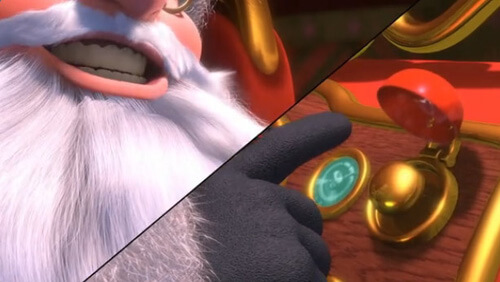
… even the back of his head …

… But you never ever get a full-on view of Santa’s face.
“That was a deliberate choice on our part,” Kevin continued. “That’s also why we went with veteran character actor Morgan Sheppard as the voice of The Big Guy. He brought sort of a gruffness to this role. Which is why you easily understand why Wayne would be kind of afraid when he dropped by Santa’s office on Christmas Day.”
Speaking of that portion of “Disney Prep and Landing,” if you look closely at what Miss Holly is typing on her typewriter, you’ll see that it’s the lyrics to “Jingle Bells.”

Beyond that … The in-jokes go from things that film buffs will appreciate (EX: The code name of Santa’s sleigh? Rosebud) …

… to gags that only members of the Deters & Wemers-Skelton clans will get. Take – for example – the toy giraffe in Timmy’s bedroom. Which is modeled after a favorite plaything of one of Kevin’s sons.

Or the name of the side of that container of milk that Wayne uses to make his late-night latte.

Or the fact that the Terwelps house (seen in miniature here in the snow globe that Santa presents to Wayne) …

… is modeled after Kevin’s boyhood home.
I know, I know. It seems like that there’s an awful lot of Deters-related material in “Disney Prep and Landing.” Not to worry, though. Ms. Wermers-Skelton gets in her licks as well with this holiday special.
Take – for example – the elf that revs up the engines on Santa’s sleigh (i.e. Dasher & Dancer). He’s voiced by Stevie.
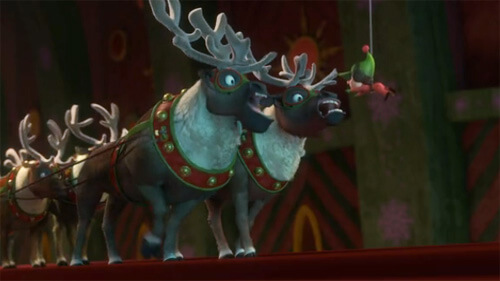
But of all the in-jokes & tributes that are featured in “Disney Prep and Landing,” I think my favorite is buried down deep in the credits for this Christmas special. Which reads:
“In Loving Memory of WALTER A. FULLER”

“And who’s Walter A. Fuller?,” you ask. Not an employee of Walt Disney Feature Animation. But – rather – an air traffic controller at Bob Hope Airport in Burbank.
So how did Fuller earn that particular tribute in “Prep and Landing” ? Well, back in the Spring of 2008, while Deters & Wermers-Skeleton were still in the research phase of this new ABC holiday special, they wanted to visit an air traffic control tower. So that the one that Magee worked in at the North Pole would then have an authentic look and feel.

As it turns out, Walter was a neighbor of Susie Coffer, who works in Development at WDAS. So Coffer arranged with Fuller to bring Deters, Wermers-Skelton as well as a few other folks from Disney up into the Burbank Tower. Where Walter then proceeded to give this group a tour that they talked about for months afterwards. Which provided all sorts of info, insights, lingo and jargon that they immediately folded into “Prep and Landing.”
Unfortunately, five months after this tower tour, Fuller was one of the 25 people who were killed in that Chatsworth Metrolink crash.
And the crew at Walt Disney Animation Studios … Given that Walter had been so helpful, so generous with his time while they were researching “Prep and Landing,” these writers, artists and animators felt that they had to something to honor the memory of this very special man.
Which explains the credit at the end of this holiday special. As well as this elf who works in the North Pole Tower.

Look familiar?
ABC’s encore presentation of “Disney Prep and Landing” airs tonight from 8-8:30 p.m. ET / PT. Which — to my way of thinking — is a perfect way to spend a half hour on Christmas Eve. If you haven’t already seen this acclaimed holiday special, be sure and check it out. To quote Lanny: “It’s so tinsel.”
And speaking of the holidays … If you’re looking to do any last minute Christmas shopping on Amazon.com, could you please do JHM a favor and – before you begin bargain hunting online – click on the above banner?
If you do that … Well, Jim Hill Media then gets a teeny tiny chunk of whatever you spend. Which would be a very nice way to show your appreciation for all the great stories that you’ve read on this site over the past year.
Happy Holidays!
Film & Movies
Before He Was 626: The Surprisingly Dark Origins of Disney’s Stitch

Hopes are high for Disney’s live-action version of Lilo & Stitch, which opens in theaters next week (on May 23rd to be exact). And – if current box office projections hold – it will sell more than $120 million worth of tickets in North America.
Stitch Before the Live-Action: What Fans Need to Know
But here’s the thing – there wouldn’t have been a hand-drawn version of Stitch to reimagine as a live-action film if it weren’t for Academy Award-winner Chris Sanders. Who – some 40 years ago – had a very different idea in mind for this project. Not an animated film or a live-action movie, for that matter. But – rather – a children’s picture book.
Sanders revealed the true origins of Lilo & Stitch in his self-published book, From Pitch to Stitch: The Origins of Disney’s Most Unusual Classic.
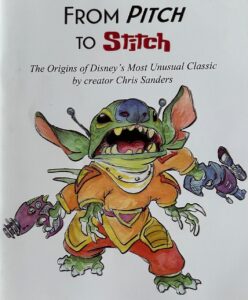
From Picture Book to Pitch Meeting
Chris – after he graduated from CalArts back in 1984 (this was three years before he began working for Disney) – landed a job at Marvel Comics. Which – because Marvel Animation was producing the Muppet Babies TV show – led to an opportunity to design characters for that animated series.
About a year into this gig (we’re now talking 1985), Sanders – in his time away from work – began noodling on a side project. As Chris recalled in From Pitch to Stitch:
“Early in my animation career, I tried writing a picture book that centered around a weird little creature that lived a solitary life in the forest. He was a monster, unsure of where he had come from, or where he belonged. I generated a concept drawing, wrote some pages and started making a sculpted version of him. But I soon abandoned it as the idea seemed too large and vague to fit in thirty pages or so.”
We now jump ahead 12 years or so. Sanders has quickly moved up through the ranks at Walt Disney Animation Studios. So much so that – by 1997 – Chris is now the Head of Story on Disney’s Mulan.


A Monster in the Forest Becomes Stitch on Earth
With Mulan deep in production, Sanders was looking for his next project when an opportunity came his way.
“I had dinner with Tom Schumacher, who was president of Feature Animation at the time. He asked if there was anything I might be interested in directing. After a little reflection, I realized that there was something: That old idea from a decade prior.”
When Sanders told Schumacher about the monster who lived alone in the forest…
“Tom offered the crucial observation that – because the animal world is already alien to us – I should consider relocating the creature to the human world.”
With that in mind, Chris dusted off the story and went to work.
Over the next three months, Sanders created a pitch book for the proposed animated film. What he came up with was very different from the version of Lilo & Stitch that eventually hit theaters in 2002.
The Most Dangerous Creature in the Known Universe
The pitch – first shared with Walt Disney Feature Animation staffers on January 9, 1998 – was titled: Lilo & Stitch: A love story of a girl and what she thinks is a dog.
This early version of Stitch was… not cute. Not cuddly. He was mean, selfish, self-centered – a career criminal. When the story opens, Stitch is in a security pod at an intergalactic trial, found guilty of 12,000 counts of hooliganism and attempted planetary enslavement.
Instead of being created by Jumba, Stitch leads a gang of marauders. His second-in-command? Ramthar, a giant, red shark-like brute.
When Stitch refuses to reveal the gang’s location, he’s sentenced to life on a maximum-security asteroid. But en route, his gang attacks the prison convoy. In the chaos, Stitch escapes in a hijacked pod and crash-lands on Earth.
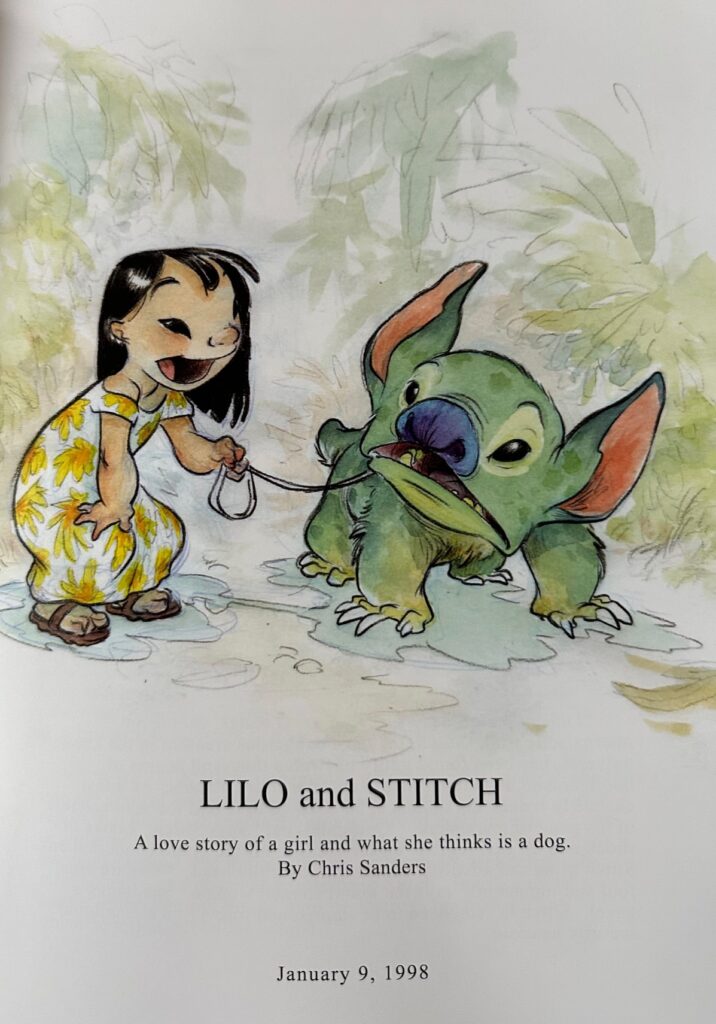

Earth in Danger, Jumba on the Hunt
Terrified of what Stitch could do to our technologically inferior planet, the Grand Council Woman sends bounty hunter Jumba – along with a rule-abiding Cultural Contamination Control agent named Pleakley – to retrieve (or eliminate) Stitch.
Their mission must be secret, follow Earth laws, and – most importantly – ensure no harm comes to any humans.
Naturally, Stitch ignores all that.
After his crash, Stitch claws out of the wreckage, sees the lights of a nearby town, and screams, “I will destroy you all!” That plan is immediately derailed when he’s run over by a convoy of sugar cane trucks.
Waking up in the local humane society, Stitch sees a news report confirming the Federation is already hot on his trail. He needs to blend in. Fast.
Enter Lilo
Lilo is a lonely little girl, mourning her parents, looking for a pet. Stitch plays the role of a “cute little doggie” because it’s a means to an end. At this point, Lilo is just someone to use while he builds a communications device.
Using parts from her toys and a stolen police radio, Stitch contacts his old gang. But Ramthar, now the leader, isn’t thrilled. Still, Stitch sends a signal.
Then he builds an army.
Stitch Goes Full Skynet
Stitch constructs a small robot, sends it to the junkyard to build bigger robots. Soon, he has an army. When Ramthar and crew arrive, Stitch’s robots surround them. Ramthar is furious, but Stitch regains command.
Next, Stitch sets his robotic horde on a nearby town. Everything goes smoothly until a robot targets the hula studio where Lilo is dancing. As it lifts her in its claw, Stitch has a change of heart. He saves her.
From here, the plot begins to resemble the Lilo & Stitch we know today. Sort of.
The Ending That Never Was
In Sanders’ original version, it’s not Captain Gantu who kidnaps Lilo, but Ramthar. And when the Grand Council Woman comes to collect Stitch, Lilo produces a receipt from the humane society.
“I paid a $4 processing fee to adopt him. If you take Stitch, you’re stealing.”
The Grand Council Woman crumples the receipt and says, “I didn’t see it.”
Nani chimes in: “Well, I saw it.”
Then Jumba. Then one of Stitch’s old crew. Then a hula girl. And finally, Pleakley pulls out his CCC badge and says:
“Well, I am Pleakley Grathor, Cultural Contamination Control Agent No. 444. And I saw it.”
Pleakley saves Stitch.
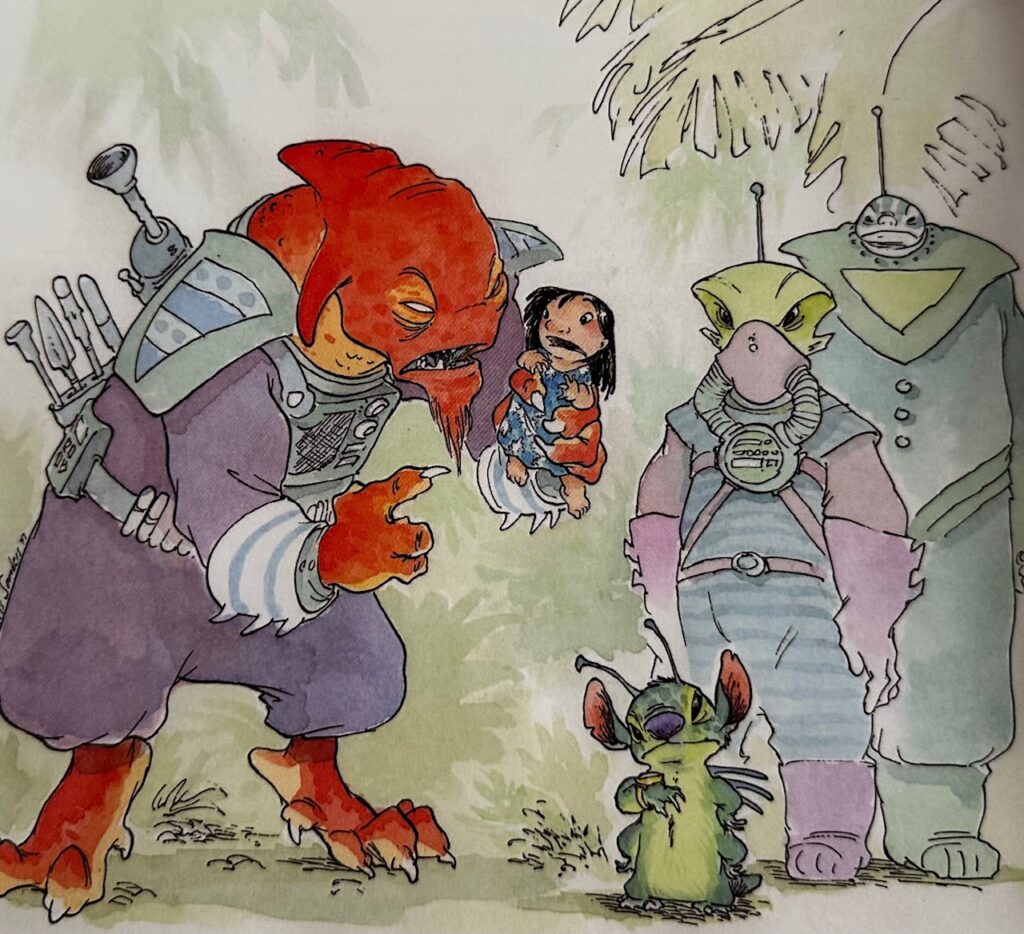

How Roy E. Disney Made Stitch Cuddly
Ultimately, this version of Lilo & Stitch was streamlined. Roy E. Disney believed Stitch shouldn’t be nasty. Just naughty. And not by choice – he was designed that way.
Which is how Stitch became Experiment 626. A misunderstood creation of Jumba the mad scientist, not a hardened criminal with a vendetta.
The rest, as they say, is history.

Ricardo Montalbán’s Lost Role
Here’s a detail that even hardcore Lilo & Stitch fans may not know: Ricardo Montalbán—best known as Mr. Roarke from Fantasy Island and Khan Noonien Singh from Star Trek II: The Wrath of Khan—was originally cast as the voice of Ramthar, Stitch’s second-in-command in this early version of the film. He had already recorded a significant amount of dialogue before the story was reworked following Roy E. Disney’s guidance. When Stitch evolved from a ruthless galactic outlaw to a misunderstood genetic experiment, Montalbán’s character (and much of the original gang concept) was written out entirely.
Which is kind of wild when you think about it. Wrath of Khan is widely considered the gold standard of Star Trek films. So yes, for a time, Khan himself was supposed to be part of Disney’s weirdest sci-fi comedy.
Stitch’s Legacy (and Why It Still Resonates)
Looking back at Stitch’s original story, it’s wild to think how close we came to getting a very different kind of movie. One where our favorite blue alien was less “ohana means family” and more “I’ll destroy you all.” But that transformation—from outlaw to outcast to ohana—is exactly what makes Lilo & Stitch so special.
So as the live-action version prepares to hit theaters, keep in mind that behind all the cuddly merch and tiki mugs lies one of Disney’s strangest, boldest, and most hard-won reinventions. One that started with a forest monster and became a beloved franchise about found family.
June 26th is officially Stitch Day—so mark your calendar. It’s a good excuse to celebrate just how far this little blue alien has come.
Film & Movies
How “An American Tail” Led to Disney’s “Hocus Pocus”

Over the last week, I’ve been delving into Witches Run Amok, Shannon Carlin’s oral history of the making of Disney’s Hocus Pocus. This book reveals some fascinating behind-the-scenes stories about the 1993 film that initially bombed at the box office but has since become a cult favorite, even spawning a sequel in 2022 that went on to become the most-watched release in Disney+ history.
But what really caught my eye in this 284-page hardcover wasn’t just the tales of Hocus Pocus’s unlikely rise to fame. Rather, it was the unexpected connections between Hocus Pocus and another beloved film—An American Tail. As it turns out, the two films share a curious origin story, one that begins in the mid-1980s, during the early days of the creative rebirth of Walt Disney Studios under Michael Eisner, Frank Wells, and Jeffrey Katzenberg.
The Birth of An American Tail
Let’s rewind to late 1984/early 1985, a period when Eisner, Wells, and Katzenberg were just getting settled at Disney and were on the hunt for fresh projects that would signal a new era at the studio. During this time, Katzenberg—tasked with revitalizing Disney Feature Animation—began meeting with talent across Hollywood, hoping to find a project that could breathe life into the struggling division.
One such meeting was with a 29-year-old writer and illustrator named David Kirschner. At the time, Kirschner’s biggest credit was illustrating children’s books featuring Muppets and Sesame Street characters, but he had an idea for a new project: a TV special about a mouse emigrating to America, culminating in the mouse’s arrival in New York Harbor on the same day as the dedication of the Statue of Liberty in 1886.

Katzenberg saw the patriotic appeal of the concept but ultimately passed on it, as he was focused on finding full-length feature projects for Disney’s animation department. Kirschner, undeterred, took his pitch elsewhere—to none other than Kathleen Kennedy, Steven Spielberg’s production partner. Kennedy was intrigued and invited Kirschner to Spielberg’s annual Fourth of July party to pitch the idea directly to the famed director.
Spielberg immediately saw the potential in Kirschner’s idea, but instead of a TV special, he envisioned a full-length animated feature film. This project would eventually become An American Tail, a tribute of sorts to Spielberg’s own grandfather, Philip Posner, who emigrated from Russia to the United States in the late 19th century. The film’s lead character, Fievel, was even named after Spielberg’s grandfather, whose Yiddish name was also Fievel.
Disney’s Loss Becomes Universal’s Gain
An American Tail went on to become a major success for Universal Pictures, which hadn’t been involved in an animated feature since the release of Pinocchio in Outer Space in 1965. Meanwhile, over at Disney, Eisner and Wells weren’t exactly thrilled that Katzenberg had let such a promising project slip through his fingers.
Not wanting to miss out on any future opportunities with Kirschner, Katzenberg quickly scheduled another meeting with him to discuss any other ideas he might have. And as fate would have it, Kirschner had just written a short story for Muppet Magazine called Halloween House, about a boy who is magically transformed into a cat by a trio of witches.
The Pitch That Sealed the Deal
Knowing Katzenberg could be a tough sell, Kirschner went all out to impress during his pitch. He requested access to the Disney lot 30 minutes early to set the stage for his presentation. When Katzenberg and the Disney development team walked into the conference room, they were greeted by a table covered in candy corn, a cauldron of dry ice fog, and a broom, mop, and vacuum cleaner suspended from the ceiling as if they were flying—evoking the magical world of Halloween House.
Katzenberg was reportedly unimpressed by the theatrical setup, muttering, “Oy, show-and-tell time” as he took his seat. But Kirschner knew exactly how to grab his attention. He started his pitch with the fact that Halloween was a billion-dollar business—a figure that made Katzenberg sit up and take notice. He listened attentively to Kirschner’s pitch, and by the time the meeting was over, Katzenberg was convinced. Halloween House would become Hocus Pocus, and Disney had its next big Halloween film.
A Bit of Hollywood Drama
Interestingly, Kirschner’s success with Hocus Pocus didn’t sit well with his old collaborators. About a year after the film’s release, Kirschner ran into Kathleen Kennedy at an Amblin holiday party, and she wasted no time in expressing her disappointment. According to Kirschner, Kennedy said, “You really hurt Steven.” When Kirschner asked how, she explained that Spielberg and Kennedy had given him his big break with An American Tail, but when he came up with the idea for his next film, he brought it to Disney rather than to them.
Hollywood can be a place where loyalty is valued—or, at least, perceived loyalty. At the same time, this was happening just as Katzenberg was leaving Disney and partnering with Spielberg and David Geffen to launch DreamWorks SKG, which only added to the tension. Loyalty, as Kirschner found out, can be an abstract concept in the entertainment industry.
A Halloween Favorite is Born
Despite its rocky start at the box office in 1993, Hocus Pocus has gone on to become a beloved part of Halloween pop culture. And, as Carlin’s book details, its success helped pave the way for more Disney Halloween-themed projects in the years that followed.

As for why Hocus Pocus was released in July of 1993 instead of during Halloween? That’s a story for another time, but it has something to do with another Halloween-themed project Disney was working on that year—Tim Burton’s The Nightmare Before Christmas—and Katzenberg finding himself in the awkward position of having to choose between keeping Bette Midler or Tim Burton happy.
For more behind-the-scenes stories about Hocus Pocus and other Disney films, be sure to check out Witches Run Amok by Shannon Carlin. It’s a fascinating read for any Disney fan!
And if you love hearing these kinds of behind-the-scenes stories about animation and film history, be sure to check out Fine Tooning with Drew Taylor, where Drew and I dive deep into all things movies, animation, and the creative decisions that shape the films we love. You can find us on your favorite podcast platforms or right here on limegreen-loris-912771.hostingersite.com.
Film & Movies
How Disney’s “Bambi” led to the creation of Smokey Bear

When people talk about Disney’s “Bambi,” the scene that they typically cite as being the one from this 1942 film which then scarred them for life is – of course – the moment in this movie where Bambi’s mother gets shot by hunters.
Which is kind of ironic. Given that – if you watch this animated feature today – you’ll see that a lot of this ruined-my-childhood scene actually happens off-camera. I mean, you hear the rifle shot that takes down Bambi’s Mom. But you don’t actually see that Mama Deer get clipped.
Now for the scariest part of that movie that you actually see on-camera … Hands down, that has to be the forest fire sequence in “Bambi.” As the grown-up Bambi & his bride, Faline, desperately race through those woods, trying to find a path to safety as literally everything around them is ablaze … That sequence is literally nightmare fuel.
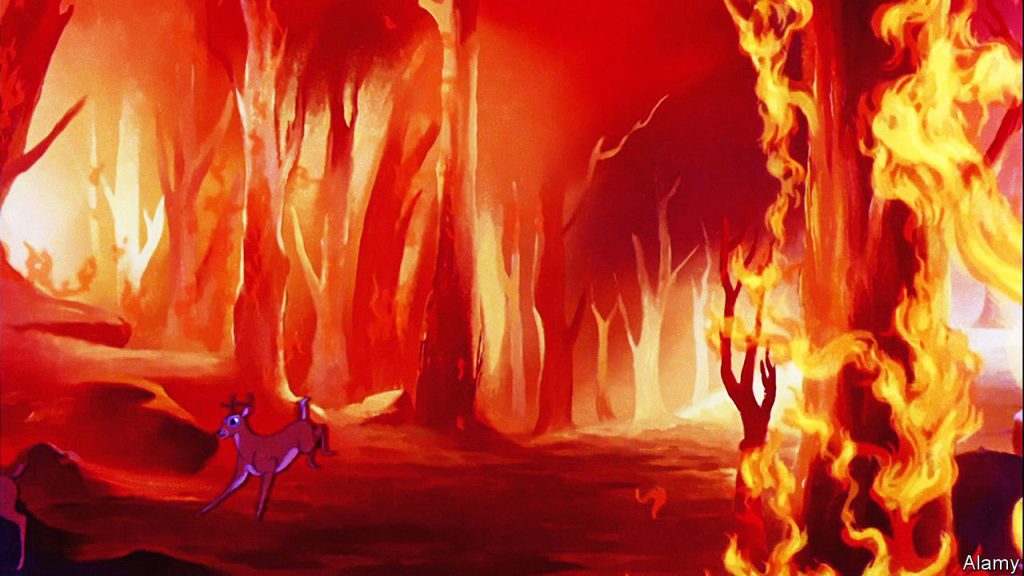
Mind you, the artists at Walt Disney Animation Studios had lots of inspiration for the forest fire sequence in “Bambi.” You see, in a typical year, the United States experiences – due to either natural phenomenon like lightning strikes or human carelessness – 100 forest fires. Whereas in 1940 (i.e., the year that Disney Studios began working in earnest of a movie version of Felix Salten’s best-selling movie), America found itself battling a record 360 forest fires.
Which greatly concerned the U.S. Forest Service. But not for the reason you might think.
Protecting the Forest for World War II
I mean, yes. Sure. Officials over in the Agricultural Department (That’s the arm of the U.S. government that manages the Forest Service) were obviously concerned about the impact that this record number of forest fires in 1940 had had on citizens. Not to mention all of the wildlife habitat that was now lost.
But to be honest, what really concerned government officials was those hundreds of thousands of acres of raw timber that had been consumed by these blazes. You see, by 1940, the world was on the cusp of the next world war. A conflict that the U.S. would inevitably be pulled into. And all that now-lost timber? It could have been used to fuel the U.S. war machine.
So with this in mind (and U.S. government officials now seeing an urgent need to preserve & protect this precious resource) … Which is why – in 1942 (just a few months after the Japanese bombed Pearl Harbor) – the U.S. Forest Service rolls out its first-ever forest fire prevention program.
Which – given that this was the early days of World War II – the slogan that the U.S. Forest Service initially chose for its forest fire prevention program is very in that era’s we’re-all-in-this-together / so-let’s-do-what-we-can-to-help-America’s war-effort esthetic – made a direct appeal to all those folks who were taking part in scrap metal drives: “Forest Defense is National Defense.”

And the poster that the U.S. Forest Service had created to support this campaign? … Well, it was well-meaning as well. It was done in the WPA style and showed men out in the forest, wielding shovels to ditch a ditch. They were trying to construct a fire break, which would then supposedly slow the forest fire that was directly behind them.
But the downside was … That “Forest Defense is National Defense” slogan – along with that poster which the U.S. Forest Service had created to support their new forest fire prevention program didn’t exactly capture America’s attention.
I mean, it was the War Years after all. A lot was going in the country at that time. But long story short: the U.S. Forest Service’s first attempt at launching a successful forest fire prevention program sank without a trace.
So what do you do in a situation like this? You regroup. You try something different.
Disney & Bambi to the Rescue
And within the U.S. government, the thinking now was “Well, what if we got a celebrity to serve as the spokesman for our new forest fire prevention program? Maybe that would then grab the public’s attention.”
The only problem was … Well, again, these are the War Years. And a lot of that era’s A-listers (people like Jimmy Stewart, Clark Gable, even Mel Brooks) had already enlisted. So there weren’t really a lot of big-name celebrities to choose from.
But then some enterprising official at the U.S. Forest Service came up with an interesting idea. He supposedly said “Hey, have you seen that new Disney movie? You know, the one with the deer? That movie has a forest fire in it. Maybe we should go talk with Walt Disney? Maybe he has some ideas about how we can better capture the public’s attention when it comes to our new forest fire prevention program?”
And it turns Walt did have an idea. Which was to use this government initiative as a way to cross-promote Disney Studio’s latest full-length animated feature, “Bambi.” Which been first released to theaters in August of 1942.
So Walt had artists at Disney Studio work up a poster that featured the grown-up versions of Bambi the Deer, Thumper the Rabbit & Flower the Skunk. As this trio stood in some tall grasses, they looked imploring out at whoever was standing in front of this poster. Above them was a piece of text that read “Please Mister, Don’t Be Careless.” And below these three cartoon characters was an additional line that read “Prevent Forest Fires. Greater Danger Than Ever!”

According to folks I’ve spoken with at Disney’s Corporate Archives, this “Bambi” -based promotional campaign for the U.S. Forest Service’s forest fire prevention campaign was a huge success. So much so that – as 1943 drew to a close – this division of the Department of Agriculture reportedly reached out to Walt to see if he’d be willing to let the U.S. Forest Service continue to use these cartoon characters to help raise the public’s awareness of fire safety.
Walt – for reasons known only to Mr. Disney – declined. Some have suggested that — because “Bambi” had actually lost money during its initial theatrical release in North America – that Walt was now looking to put that project behind him. And if there were posters plastered all over the place that then used the “Bambi” characters that then promoted the U.S.’s forest fire prevention efforts … Well, it would then be far harder for Mr. Disney to put this particular animated feature in the rear view mirror.
Introducing Smokey Bear
Long story short: Walt said “No” when it came to reusing the “Bambi” characters to promote the U.S. Forest Service’s forest fire prevention program. But given how successful the previous cartoon-based promotional campaign had been … Well, some enterprising employee at the Department of Agriculture reportedly said “Why don’t we come up with a cartoon character of our own?”
So – for the Summer of 1944 – the U.S. Forest Service (with the help of the Ad Council and the National Association of State Foresters) came up with a character to help promote the prevention of forest fires. And his name is Smokey Bear.
Now a lot of thought had gone into Smokey’s creation. Right from the get-go, it was decided that he would be an American black bear (NOT a brown bear or a grizzly). To make this character seem approachable, Smokey was outfitted with a ranger’s hat. He also wore a pair of blue jeans & carried a bucket.
As for his debut poster, Smokey was depicted as pouring water over a still-smoldering campfire. And below this cartoon character was printed Smokey’s initial catchphrase. Which was “Care will prevent 9 out of 10 forest fires!”

Which makes me think that this slogan was written by the very advertising executive who wrote “Four out of five dentists recommend sugarless gum for their patients who chew gum.”
Anyway … By the Summer of 1947, Smokey got a brand-new slogan. The one that he uses even today. Which is “Only YOU can prevent forest fires.”
The Real Smokey Bear
Now where this gets interesting is – in the Summer of 1950 – there was a terrible forest fire up in the Capitan Mountains of New Mexico. And over the course of this blaze, a bear cub climbed high up into a tree to try & escape those flames.
Firefighters were finally able to rescue that cub. But he was so badly injured in that fire that he was shipped off to the National Zoo in Washington, D.C. and nursed back to health. And since this bear really couldn’t be released back in the wild at this point, he was then put on exhibit.
And what does this bear’s keepers decide to call him? You guessed it: Smokey.

And due to all the news coverage that this orphaned bear got, he eventually became the living symbol of the U.S. Forest Service’s forest fire prevention program. Which then meant that this particular Smokey Bear got hit with a ton of fan mail. So much so that the National Zoo in Washington D.C. wound up with its own Zip Code.
“Smokey the Bear” Hit Song
And on the heels of a really-for-real Smokey Bear taking up residence in our nation’s capital, Steve Nelson & Jack Rollins decide to write a song that shined a spotlight on this fire-fightin’ bruin. Here’s the opening stanza:
With a ranger’s hat and shovel and a pair of dungarees,
You will find him in the forest always sniffin’ at the breeze,
People stop and pay attention when he tells them to beware
Because everybody knows that he’s the fire-preventin’ bear
Believe or not, even with lyrics like these, “Smokey the Bear” briefly topped the Country charts in the Summer of 1950. Thanks to a version of this song that was recorded by Gene Autry, the Singing Cowboy.
By the way, it was this song that started all of the confusion in regards to Smokey Bear’s now. You see, Nelson & Rollins – because they need the lyrics of their song to scan properly – opted to call this fire-fightin’-bruin Smokey THE Bear. Rather than Smokey Bear. Which has been this cartoon character’s official name since the U.S. Forest Service first introduced him back in 1944.
“The Ballad of Smokey the Bear”
Further complicating this issue was “The Ballad of Smokey the Bear,” which was a stop-motion animated special that debuted on NBC in late November of 1966. Produced by Rankin-Bass as a follow-up to their hugely popular “Rudolph the Red-Nosed Reindeer” (which premiered on the Peacock Network in December of 1964) … This hour-long TV show also put a “THE” in the middle of Smokey Bear’s name because the folks at Rankin-Bass thought his name sounded better that way.
And speaking of animation … Disney’s “Bambi” made a brief return to the promotional campaign for the U.S. Forest Service’s forest fire prevention program in the late 1980s. This was because the Company’s home entertainment division had decided to release this full-length animated feature on VHS.
What’s kind of interesting, though, is the language used on the “Bambi” poster is a wee different than the language that’s used on Smokey’s poster. It reads “Protect Our Forest Friends. Only You Can Prevent Wildfires.” NOT “Forest Fires.”
Anyway, that’s how Disney’s “Bambi” led to the creation of Smokey Bear. Thanks for bearin’ with me as I clawed my way through this grizzly tale.
-

 Theme Parks & Themed Entertainment8 months ago
Theme Parks & Themed Entertainment8 months agoDisney’s Forgotten Halloween Event: The Original Little Monsters on Main Street
-

 Theme Parks & Themed Entertainment9 months ago
Theme Parks & Themed Entertainment9 months agoThe Story of Mickey’s Not-So-Scary Halloween Party: From One Night to a Halloween Family Tradition
-

 Film & Movies9 months ago
Film & Movies9 months agoHow “An American Tail” Led to Disney’s “Hocus Pocus”
-

 Theme Parks & Themed Entertainment7 months ago
Theme Parks & Themed Entertainment7 months agoDisney and Macy’s 90-Year Thanksgiving Day Parade Partnership: From Mickey’s First Balloon to Minnie’s Big Debut
-

 Television & Shows5 months ago
Television & Shows5 months agoHow the Creators of South Park Tricked A-List Celebrities to Roast Universal – “Your Studio & You”
-

 History4 months ago
History4 months agoThe Super Bowl & Disney: The Untold Story Behind ‘I’m Going to Disneyland!’
-
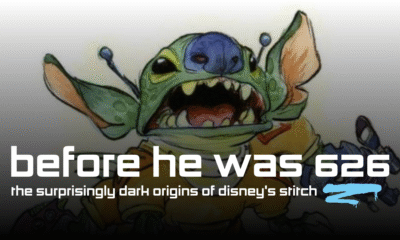
 Film & Movies2 weeks ago
Film & Movies2 weeks agoBefore He Was 626: The Surprisingly Dark Origins of Disney’s Stitch
-

 Podcast2 months ago
Podcast2 months agoEpic Universal Podcast – Aztec Dancers, Mariachis, Tequila, and Ceremonial Sacrifices?! (Ep. 45)








